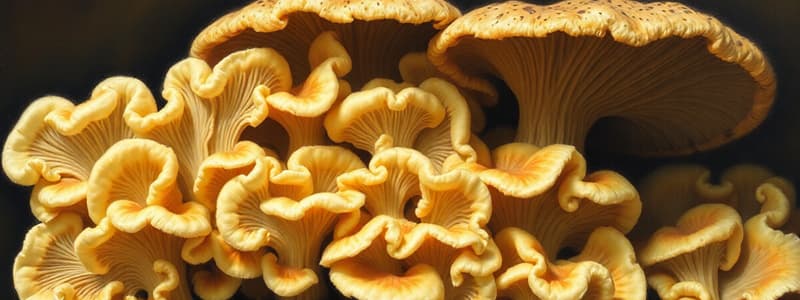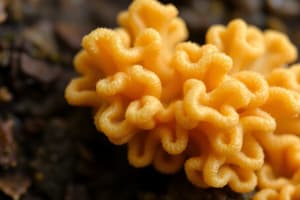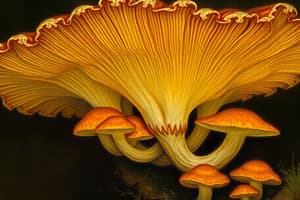Podcast
Questions and Answers
Which of the following describes the primary function of sporangia in fungi?
Which of the following describes the primary function of sporangia in fungi?
- Forming a network of hyphae known as the mycelium.
- Producing and housing spores for asexual reproduction. (correct)
- Aiding in nutrient absorption from the surrounding environment.
- Facilitating sexual reproduction through the fusion of hyphae.
In the sexual reproduction of Ascomycota fungi, what is the role of the trichogyne?
In the sexual reproduction of Ascomycota fungi, what is the role of the trichogyne?
- It directly develops into ascospores after plasmogamy.
- It is a sterile filament that supports the asci within the ascocarp.
- It serves as a bridge for the male nuclei to pass from the antheridium to the ascogonium. (correct)
- It is the structure where karyogamy takes place, leading to meiosis.
Which of the following is a characteristic of conidia?
Which of the following is a characteristic of conidia?
- They are formed within specialized sac-like structures called asci.
- They are endogenous spores produced inside sporangia.
- They are flagellated spores that swim to new locations.
- They are exogenous spores formed outside of sporangia. (correct)
What is the immediate result of karyogamy in asci?
What is the immediate result of karyogamy in asci?
Which of the following lists the correct order of events that lead to the formation of ascospores during sexual reproduction in Ascomycota?
Which of the following lists the correct order of events that lead to the formation of ascospores during sexual reproduction in Ascomycota?
Flashcards
Asexual Reproduction in Fungi
Asexual Reproduction in Fungi
Fungi reproduce without the fusion of gametes; includes budding and fragmentation.
Hyphae
Hyphae
Filamentous structures that make up the body of fungi, can be coenocytic.
Dikaryotic Stage
Dikaryotic Stage
A stage in the life cycle of fungi where two haploid nuclei exist within a single cell.
Conidia
Conidia
Signup and view all the flashcards
Ascocarp
Ascocarp
Signup and view all the flashcards
Study Notes
Fungi Reproduction
- Fungi reproduce both sexually and asexually
- They transition from a haploid stage to a diploid stage
- Ascomycota and Basidiomycota undergo a dikaryotic stage
Fungi Structure
- Fungi can be beneficial or parasitic
- Hyphae: Filaments constructed of cells (e.g., Coenocytic)
- Mycelium: Network of hyphae
- Sporangium: Located at the tip of hyphae; responsible for spore production
Asexual Reproduction
- Budding: Formation of a bud (e.g., unicellular yeast)
- Fragmentation: A long mycelium divides into pieces, each growing into a new mycelium
Spore Formation
- Spore formation varies depending on the type of fungus (e.g., Basidiomycota)
- Spores can be dormant in unfavorable conditions; active in favorable conditions
- Spores are non-motile (non-flagellated)
- Spores can be outside the sporangium (conidia) or inside (sporangia spores)
- Examples of fungi producing conidia: Ascomycota, Basidiomycota, Penicillium
- Example of fungi producing sporangia spores: Rhizopus
Sexual Reproduction
- Ascomycota (sac fungi)
- Antheridium: Male gametangium on the (-) mycelium
- Ascogonium: Female gametangium on the (+) mycelium
- Stages of reproduction: hyphae from (+) and (-) strains fuse; male nuclei from antheridium move into ascogonium via trichogyne (an extension of the ascogonium). Plasmogamy occurs.
- Dikaryotic hyphae form from the fusion; cells (asci) at the tip of hyphae form a sac-like structure
- Asci undergo karyogamy
- Asci and sterile filaments (paraphyses) are in an ascocarp
- Meiosis occurs after karyogamy in asci, producing ascospores
- Ascospores germinate, forming new haploid mycelium
- Asexual reproduction is also possible
Studying That Suits You
Use AI to generate personalized quizzes and flashcards to suit your learning preferences.




